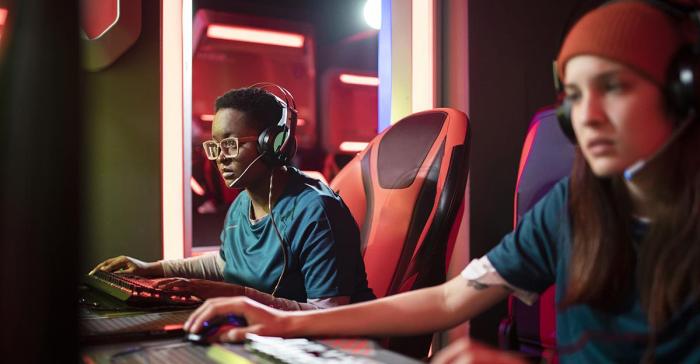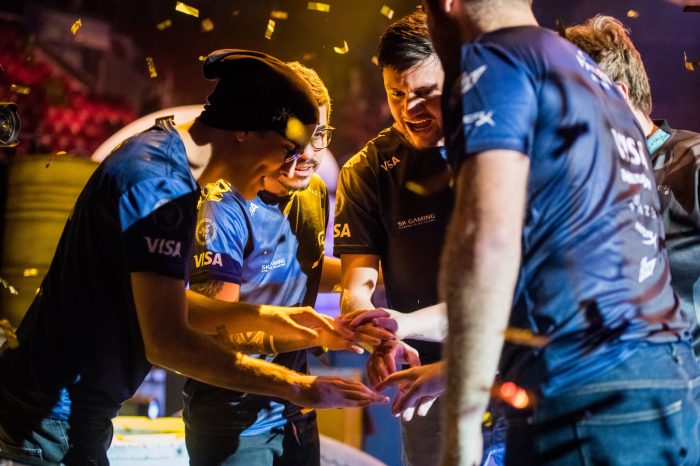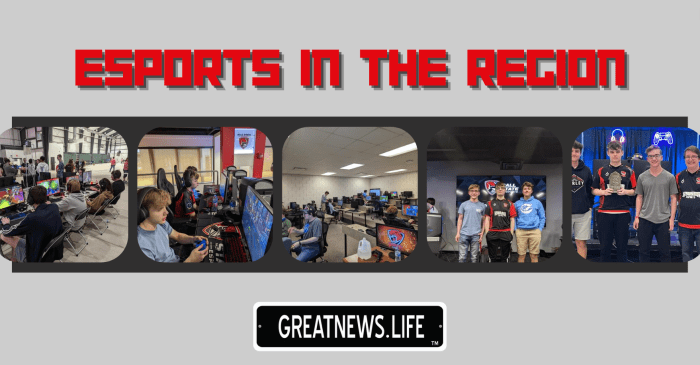Esports skill development isn’t just about reflexes; it’s a multifaceted beast encompassing strategy, mental grit, and even physical fitness. Think of it like this: you wouldn’t expect a pro basketball player to just show up and shoot hoops, right? Similarly, top esports players hone their skills through rigorous training, strategic analysis, and a whole lot of mental toughness.
This deep dive explores the various elements that contribute to success in the competitive world of esports, from mastering in-game mechanics to crushing the mental game.
We’ll cover everything from the specific skills needed for different game genres – think the pinpoint accuracy of an FPS player versus the strategic thinking of an RTS pro – to the importance of teamwork and communication. We’ll also touch on the role of technology in training, including the use of advanced analytics and even VR/AR. Get ready to unlock your inner esports champion!
Defining Esports Skill Development

Esports skill development isn’t just about getting good at a game; it’s a multifaceted process encompassing cognitive, physical, and strategic abilities. Success hinges on a complex interplay of these elements, varying significantly depending on the game genre. Understanding these components is crucial for players aiming to reach peak performance.Esports skill development involves honing a range of abilities that contribute to success in competitive gaming.
This goes beyond simply mastering the mechanics; it includes strategic thinking, adaptability, and even physical conditioning. The specific skills needed will vary depending on the game, but a common thread is the need for continuous learning and improvement.
Cognitive Skills in Esports
Cognitive skills are fundamental to success in any esports title. These skills allow players to process information quickly, make strategic decisions under pressure, and adapt to changing game situations. Examples include reaction time, decision-making speed, spatial awareness, and problem-solving abilities. For instance, in a fast-paced FPS like
Counter-Strike
Global Offensive*, rapid reaction time is critical for winning gunfights, while strategic thinking is essential for coordinating team movements and executing successful map strategies. In more complex games like
StarCraft II*, spatial awareness and efficient resource management are vital for maintaining an advantage over opponents.
Physical Skills in Esports
While often overlooked, physical skills play a surprisingly significant role in esports. These skills contribute to endurance, precision, and overall performance. Maintaining good posture, hand-eye coordination, and even managing stress through proper breathing techniques are crucial for extended gameplay sessions. Professional players often undergo rigorous physical training to enhance these aspects. For example, aLeague of Legends* player needs good hand-eye coordination to execute complex combos and micro-manage their champion’s abilities accurately.
Maintaining focus during lengthy matches requires significant mental and physical stamina.
Strategic Skills in Esports
Strategic skills encompass the ability to plan, adapt, and execute effective strategies. This includes understanding game mechanics, predicting opponent actions, and working effectively as part of a team. Different esports genres demand varying levels of strategic depth. In a MOBA like
- Dota 2*, strategic thinking is paramount, requiring players to coordinate team compositions, lane assignments, and objective control. Real-time strategy (RTS) games like
- StarCraft II* necessitate quick decision-making, resource management, and understanding of unit compositions and counter-strategies. Successful teams in these games often display exceptional macro-level strategic planning combined with precise micro-level execution.
Skill Application Across Esports Genres
The contribution of individual skills to overall team performance varies widely across esports genres. In First-Person Shooters (FPS) like
- Call of Duty*, individual aim and reaction time are crucial, but team coordination and communication are equally important for successful map control and objective capture. In Multiplayer Online Battle Arenas (MOBAs) such as
- League of Legends*, individual laning skills are important, but team fighting, strategic decision-making, and communication are paramount for winning team fights and securing objectives. In Real-Time Strategy (RTS) games like
- StarCraft II*, macro-management skills (resource gathering, base building) and micro-management skills (unit control, combat execution) are both crucial, but effective teamwork and adaptability are key to victory against skilled opponents. The success of any team depends on the synergistic interplay of individual and collective skills.
Analyzing Gameplay and Improving Performance

Analyzing your gameplay is crucial for leveling up your esports skills. It’s not just about watching yourself play; it’s about systematically identifying weaknesses and developing strategies to overcome them. Think of it like a sports coach reviewing game film – you need a structured approach to extract meaningful insights and translate them into actionable improvements. This process allows for targeted practice, maximizing your training efficiency and ultimately boosting your performance.Gameplay analysis involves a methodical review of recorded matches, focusing on specific metrics and identifying patterns in your actions and your team’s performance.
By objectively assessing your strengths and weaknesses, you can pinpoint areas requiring focused improvement. This process is iterative; you analyze, adjust your strategy, practice the adjustments, and then re-analyze to see the impact of your changes.
Identifying Areas for Improvement Through Gameplay Footage
Effective gameplay analysis starts with recording your matches. This allows for repeated review, enabling you to notice subtle mistakes or missed opportunities that you might not catch in real-time. During review, focus on specific moments – both successful plays and unsuccessful ones. Analyze your decision-making process, your execution, and the overall flow of the game. Consider external factors like opponent strategies and team coordination.
Ask yourself: Where did I make critical errors? What opportunities did I miss? Could I have reacted faster or made a better strategic choice? Were my team’s actions efficient, or did we have communication breakdowns? By identifying these patterns, you can start building a plan for improvement.
Key Metrics and Data Points for Performance Tracking
Tracking specific metrics provides quantifiable data to support your qualitative analysis. For example, in a first-person shooter, you might track your K/D ratio (kills to deaths), accuracy, average damage per round, and time to kill. In a MOBA, you could focus on CS (creep score) per minute, kill participation rate, and ward placement efficiency. These metrics offer objective measures of your performance, allowing you to identify areas where you excel and areas needing work.
Additionally, tracking things like average game duration and win rate provide a broader view of your overall effectiveness. Comparing these metrics across multiple matches allows you to identify trends and measure the impact of your training efforts.
A Step-by-Step Guide to Gameplay Analysis for Skill Improvement
- Record your gameplay: Utilize in-game recording features or external software to capture your matches.
- Choose a specific match to analyze: Select a match that highlights both strong and weak performances to get a balanced perspective.
- Review the match: Watch the recording multiple times, focusing on different aspects each time (e.g., your positioning, decision-making, communication).
- Identify key moments: Note down instances of successful plays, mistakes, and missed opportunities. Be specific – note the exact time stamps and what happened.
- Analyze the data: Review relevant in-game statistics (K/D, CS/min, etc.) to support your qualitative observations.
- Identify patterns and trends: Look for recurring mistakes or areas where you consistently underperform.
- Develop a plan for improvement: Based on your analysis, create a specific training plan to address your weaknesses. This might involve practicing aim, improving map awareness, or working on team communication strategies.
- Implement the plan and re-analyze: Practice the strategies you’ve developed, then record and analyze another match to assess your progress. This iterative process is crucial for continuous improvement.
Technological Advancements and Esports Skill Development

Technological advancements are rapidly reshaping the esports landscape, moving beyond simple screen-based gameplay to create incredibly immersive and data-driven training environments. This evolution is not just about enhancing the gaming experience; it’s fundamentally changing how players train, improve, and compete at the highest levels. The integration of cutting-edge technologies is pushing the boundaries of skill development, allowing for unprecedented levels of precision, personalization, and efficiency in training regimens.The impact of these advancements is multifaceted, influencing everything from player performance analysis to the development of personalized training programs.
This section will explore how specific technologies, such as VR/AR and AI, are transforming the way esports athletes prepare for competition.
VR/AR Training and its Transformative Impact
Virtual and augmented reality technologies offer unparalleled opportunities for immersive training. VR allows players to practice in simulated environments that perfectly replicate the conditions of real matches, offering a safe space to experiment with strategies and refine techniques without the pressure of live competition. Imagine a Counter-Strike player practicing map navigation and enemy engagement in a fully realized virtual version of Dust II, complete with realistic enemy AI and dynamic environmental factors.
This level of immersion allows for a deeper understanding of spatial awareness, timing, and decision-making under pressure, all crucial elements of high-level play. Meanwhile, AR can overlay real-time data and feedback onto a player’s actual gameplay, providing insights into their performance that might otherwise be missed. For example, an AR system could highlight a player’s aiming accuracy, reaction times, or even their in-game positioning in relation to their teammates, allowing for immediate adjustments and improvements.
The combination of VR and AR creates a powerful training tool, offering a blend of immersive practice and real-time performance analysis.
AI-Powered Coaching Tools: The Future of Esports Training
AI is poised to revolutionize esports coaching. AI-powered tools can analyze vast amounts of gameplay data, identifying strengths, weaknesses, and areas for improvement far more efficiently than a human coach. These tools can go beyond simple statistics, providing detailed breakdowns of player decision-making, identifying patterns in gameplay, and even suggesting optimal strategies based on opponent behavior. For example, an AI coach could analyze thousands of replays of a League of Legends match to identify recurring mistakes in a player’s laning phase, suggesting specific adjustments to their item builds, champion selection, or even their overall play style.
Moreover, AI can personalize training programs, tailoring exercises and drills to a player’s specific needs and skill level. This allows for more efficient use of training time and a more targeted approach to skill development. While human coaches will still remain vital for strategic guidance and mentorship, AI will play an increasingly important role in optimizing training and maximizing player potential.
A Hypothetical High-Tech Esports Training Environment, Esports skill development
Imagine a state-of-the-art training facility where esports athletes train in fully immersive VR environments. These environments wouldn’t just replicate game maps; they would simulate the entire competitive experience, including the pressure of a live audience, the communication with teammates, and even the physical sensations of intense gameplay. Players would wear haptic suits providing sensory feedback, allowing them to feel the recoil of a virtual weapon or the impact of a virtual collision.
Biometric sensors would monitor their heart rate, sweat levels, and other physiological data, providing real-time insights into their stress levels and mental state. This data would be fed into an AI-powered coaching system that provides personalized feedback and adjusts the training regimen accordingly. Furthermore, AR overlays would provide real-time performance analysis, highlighting areas for improvement and suggesting optimal strategies.
This hypothetical training environment would combine the benefits of immersive VR, personalized AI coaching, and detailed biometric feedback to create a truly optimized and effective training experience, pushing the boundaries of human performance in esports.
User Queries
What’s the best way to find a good esports coach?
Look for coaches with proven track records, positive player reviews, and experience in your specific game. Online communities and forums are great resources.
How important is sleep for esports performance?
Super important! Lack of sleep hurts reaction time, focus, and decision-making. Aim for 7-9 hours of quality sleep per night.
What are some common physical injuries related to esports?
Carpal tunnel syndrome, eye strain, back pain, and neck pain are common. Good posture, regular breaks, and stretching are key.
How can I improve my in-game communication?
Practice clear and concise communication. Use in-game voice chat effectively, and learn to give and receive constructive feedback.
